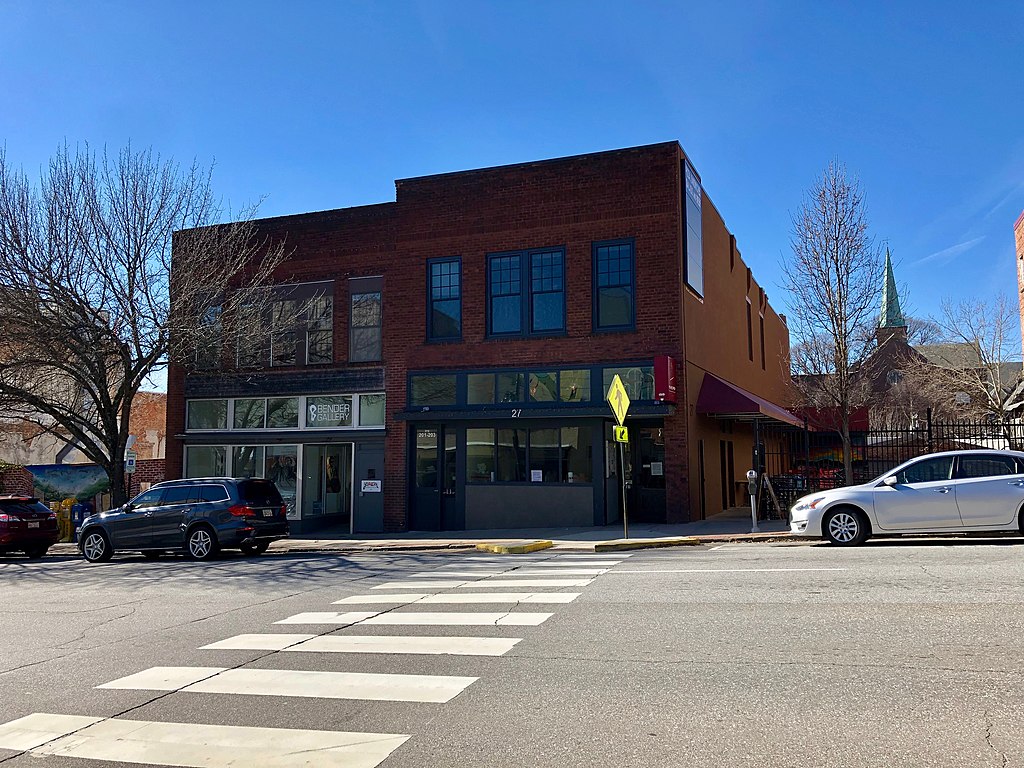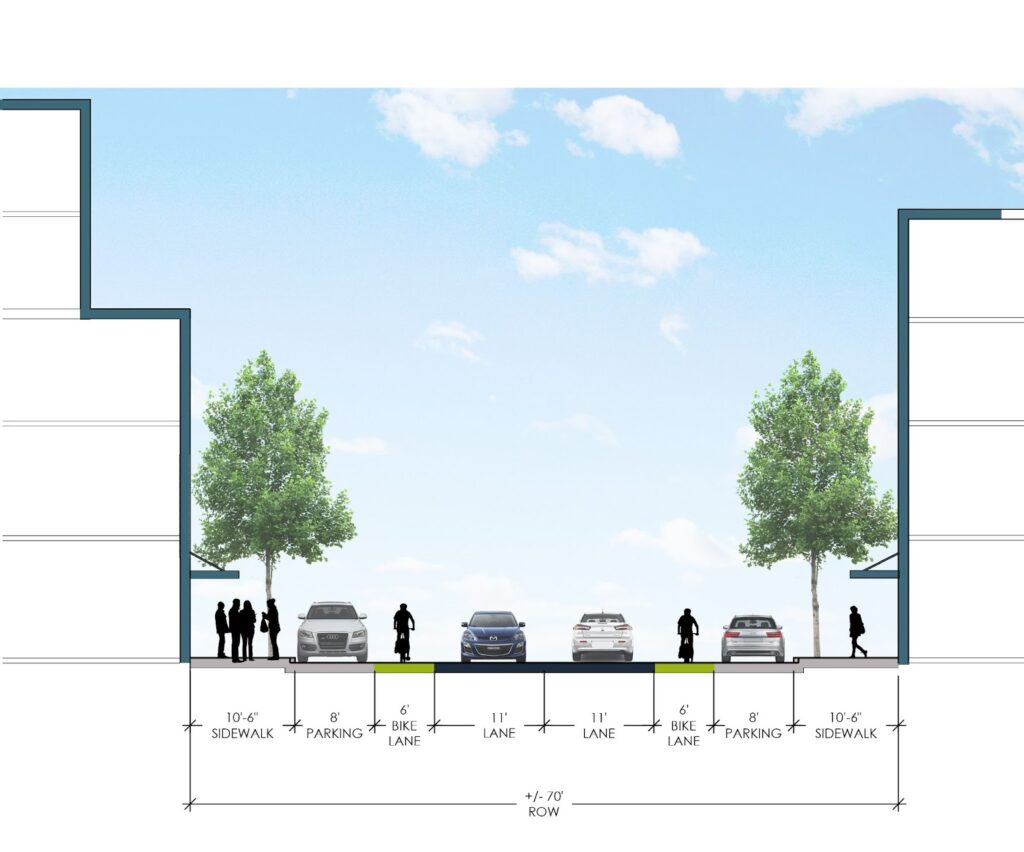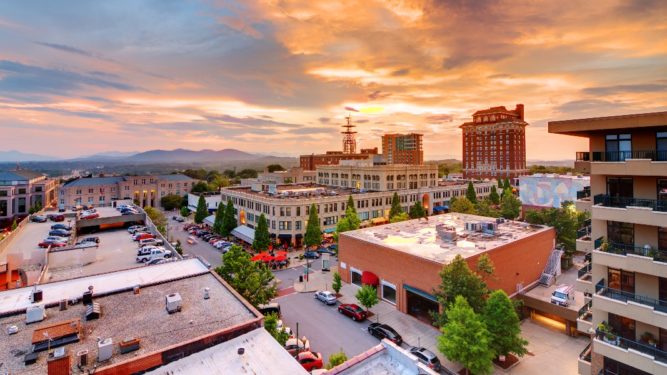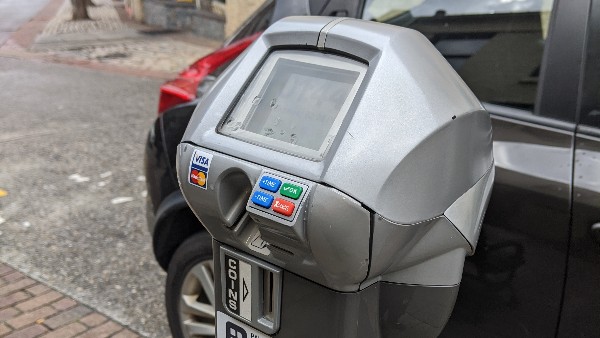Happening Now
The City determined not to move forward with the project in conjunction with NCDOT’s resurfacing project due to timing constraints and the desire for additional outreach. However, the City will continue to evaluate the project in the future.
Background
Throughout 2022 and 2023, the North Carolina Department of Transportation (NCDOT) will be re-paving and re-striping portions of US 25, including Merrimon Avenue and Broadway and Biltmore Downtown. The City of Asheville had conversations with NCDOT and the public on re-striping/reconfiguration plans for these streets to identify opportunities to add multimodal facilities.
On Merrimon Avenue, a 4 to 3 lane conversion will be implemented between Midland and W.T. Weaver. A similar reconfiguration was proposed for Biltmore Avenue between Patton Avenue and Hilliard Avenue. The reconfiguration would incorporate dedicated bike lanes in both directions and the removal of one southbound vehicular travel lane. However, due to project timing constraints and the desire for additional outreach, the Biltmore Avenue reconfiguration was put on hold. NCDOT will continue to more forward with the resurfacing project. The City will consider a reconfiguration in the future, as separate project from NCDOT efforts.
Proposed Project
Currently, the curb-to-curb distance is 45-50 feet and consists of two 10-foot southbound vehicular lanes and one 14-foot northbound vehicular lane (wider than the typical standard). Additionally, there are +/- 8-foot wide parking/loading lanes on both sides of the street.
To add bicycle facilities to this section of the corridor, one of the two southbound vehicular travel lanes would need to be removed and the northbound lane would be narrowed. No changes to the parking/loading lane would be made; however, we expect to add additional loading zones. Proposed additional and expanded loading zones are shown in these documents: Section 1 and Section 2.
Proposed Cross Section – Biltmore Avenue between Patton Avenue and Hilliard Avenue
Project Goals and Objectives
The primary objective of the proposal is to increase multimodal connectivity, which includes expanding dedicated bicycle infrastructure throughout the city’s urban core.
Increasing bicycle infrastructure and providing a connected network also indirectly supports a number of City goals related to affordability, community health, and sustainability. In particular, transportation costs are typically the 2nd largest household expense behind housing costs (rent/mortgage, utilities, etc.). Improving affordability in Asheville is therefore more than just providing more affordable housing, but also working to decrease transportation costs by providing alternatives to vehicle ownership.
Timeline of Public Outreach Completed
- June 10 – Downtown Commission – supported by all but one member present.
- June 22 – Multimodal Transportation Commission – supported unanimously.
- July 13 – Letter sent to property owners in the corridor with info and link to project website.
- July 20 – Email sent to business owners whose contact info was on file.
- July 22 – Door-to-door outreach conducted and letter/flyer with project info provided; impromptu meeting with roughly 10 business owners/managers on the corridor.
- July 26 and 28 – Virtual meetings held. Roughly 10 attendees total including property and business owners/managers.
- August 9, 8:30 a.m. – Virtual public meeting to answer questions and discuss concerns.
- August 10, noon – Asheville Downtown Association meeting (virtual) to discuss the project.
- August 10 – 4:00 p.m. – In-person meeting with anyone who wants to discuss the project. Met on the corner of Eagle and Biltmore.
- August 11 – 9:00 a.m. – In-person meeting with anyone who wants to discuss the project. Met on the corner of Eagle and Biltmore.
- August 12, 9:00 a.m. – Downtown Commission meeting to present the project and answer questions.
Project Opportunities and Concerns
The table below summarizes the opportunities associated with installing the bicycle facilities, as well as the concerns heard thus far through the public engagement process.
Opportunities |
Concerns |
| A dedicated bicycle facility provides improved safety for roadway users by providing dedicated space and visibility for bicyclists, and more predictability for drivers. | Project requires removal of one southbound vehicular travel lane in this section. This lane is often used by commercial delivery trucks to double-park in order to make deliveries. |
| Creation of a connected bicycle network within and to/from downtown provides another affordable transportation option to access downtown business and services. | Existing loading zones are insufficient in number and are not sized/configured for large-trucks. |
|
Adding bicycle/mobility facilities has been shown to reduce parking demand and increase economic development. |
Some existing on-street parking spaces may be converted to loading, which will likely decrease the number of metered spaces. |
| The bike lanes would connect to the existing bike lane on Hilliard as well as the planned lanes on College/Patton Avenue downtown. | Business concerns that bike lanes will not be used enough to warrant removal of a vehicle lane. |
| No required changes to traffic signals or expected significant impact on traffic flow. |
|
| No changes or impacts to business access or driveways. |
Business concerns regarding safety of roadway users, including pedestrians, vehicles, and bicyclists due to the high activity in the corridor. |
| No cost to the City, since NCDOT will be repaving and re-striping the street. |
Overall concern regarding limited outreach and time to provide comments. |
| Business concerns that City Council is not making the decision and that this is “staff-led.” |
Many of the comments that have been received, as well as conversations that have taken place with business owners, are related to loading/unloading activities. There is understandable concern among some business owners that removing one of the southbound lanes will be detrimental to receiving deliveries since the outside lane is used frequently by delivery trucks.
With or without bike lanes, there is a clear need to improve the loading zone access in this corridor. The City will work with DOT to install additional loading areas with the project regardless of whether bike lanes are installed. Adding these loading spaces is intended to eliminate the need for delivery drivers to double-park in the vehicle lane to unload/load.
Additionally, concerns about safety, including speeding, congestion, pedestrian activity/crossings, and emergency services access have been raised via public comment.
- Speed – The City is discussing the potential to reduce the speed limit on Biltmore south of Aston, which is currently 35 mph (it is 20 north of Aston). While this decision-making process will be separate, DOT has indicated that a lower speed limit may be warranted.
- Congestion – Neither the City or NCDOT expect traffic operations to worsen if one of the southbound vehicle lanes south of Patton is removed. This is because the traffic volumes on Biltmore/Broadway are the same both north and south of Patton ( 9,800-10,000 per day), and there’s only one lane in each direction north of Patton.
- Pedestrians – Given the level of pedestrian activity on the corridor, the City will be working with DOT to evaluate whether an additional crosswalk can be added somewhere between Aston and Hilliard. This will also likely be a separate process, and if we are able to add a crosswalk, it would be after the overall repaving project is completed. There are several factors that DOT considers when evaluating whether crosswalks can be added, including speeds, number of lanes, and pedestrian activity.
- Emergency services – The City does not expect emergency services (police, fire, EMS) access to be negatively impacted if a southbound vehicle lane is removed. In fact, it may be improved. This is because the curb-to-curb distance (width of the street) is not changing. As with similar projects and on similar roadways, if emergency vehicles are approaching, drivers move over into the bicycle lane to allow emergency vehicles to pass. The same street width is available for emergency vehicles to pass through.
Timeline
- July to August 2022 – Public engagement
- September 2023 – Project put on hold for future evaluation by City (NCDOT to move forward with resurfacing)
Supporting Documents
The following adopted City plans support the addition of bicycle facilities in Asheville, both in general and on Biltmore Avenue specifically:
- Living Asheville: A Comprehensive Plan For Our Future (2018) – general
- Asheville in Motion Mobility Plan (2017) – general and specific to Biltmore.
- Biltmore McDowell Corridor Study (2021) – specific to Biltmore.
- City of Asheville Complete Streets Policy (2012) – general
- City of Asheville Comprehensive Bicycle Plan (2008 – superseded by Asheville in Motion Plan) – general and specific to Biltmore.
Contact Information
Jessica Morriss, Assistant Director, Transportation, jmorriss@ashevillenc.gov




